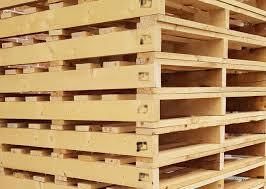Pallets are the unsung heroes of Australia’s logistics and manufacturing sectors. These humble platforms streamline goods movement and storage, keeping operations humming. However, not all pallets are created equal. Understanding size variations and standards is key to optimising transport, cutting costs, and boosting efficiency. Australian pallet norms diverge from global practices, adding complexity for businesses. Selecting the ideal pallet from an ideal pallet manufacturer in Melbourne is a strategic decision that can make or break your supply chain.
Australian Standard Pallet Size
Optimising logistics, the 1165mm x 1165mm pallet reigns supreme in Australia. Introduced in the 1960s, this standard size revolutionised supply chains nationwide. Its perfect fit with racking systems, vehicles, and containers maximises efficiency. The pallet’s widespread adoption transformed storage and transport operations. Now ubiquitous, this square platform underpins Australia’s freight industry, seamlessly integrating with common configurations. Its enduring success stems from unmatched compatibility with local infrastructure.
Key Specifications of the Australian Standard Pallet:
– 1165 mm x 1165 mm (45.87 inches x 45.87 inches)
– Usually made of wood, but some industries may also use plastic or metal.
– Supports a load of up to 2,000 kg (4,409 lbs) when evenly distributed.
– Weighs 30 to 40 kg, depending on the material and build quality.
Australia’s vast market thrives on the 1165 mm x 1165 mm standard pallet. This uniform size streamlines supply chains, fostering efficiency across diverse regions. Yet, its uniqueness poses challenges for international shipping. Businesses must navigate this dichotomy of balancing domestic consistency with global compatibility. As we explore further, the interplay between local standards and worldwide logistics becomes increasingly significant.
International Pallet Sizes and Compatibility
From pallets to profits, size matters in global trade. Australia’s 1165mm square design diverges from international norms, creating both challenges and opportunities. Exporters must either adapt or risk complications. By recognising this standard, businesses try to transform potential pitfalls into competitive advantages.
The most common international pallet sizes include:
– Euro Pallet Size (EUR/EPAL Pallet): 1200 mm x 800 mm, widely used across Europe.
– North American Pallet (GMA Pallet): 1219 mm x 1016 mm (48 x 40 inches). It’s the common size in the U.S. and Canada.
– ISO Pallet: 1200 mm x 1000 mm, accepted in many parts of the world, including Asia and Europe.
These differences impact space efficiency in shipping containers. North American and Euro pallet sizes don’t align with Australian pallets. Consequently, exporters confront two costly options. They can use standard pallets, wasting valuable container space, or they may opt for custom-sized pallets, increasing expenses. Both choices result in higher shipping costs.
The Importance of Choosing the Right Pallet for Export
Australian exporters struggle with incompatible pallet sizes in foreign markets. The solution? Adopting international standards. Two options stand out — the 1200mm x 1000mm ISO pallet and the 1200mm x 800mm Euro pallet size. These sizes solve multiple issues.
- Fit seamlessly into global supply chains, reducing transport complications.
- Storage becomes simpler upon arrival.
- Distribution proceeds without a hitch.
By choosing these standardised pallets, businesses can avoid logistical headaches and ensure smooth operations abroad. This approach transforms a potential obstacle into a strategic advantage for Australian goods in the global marketplace.
Sometimes, wooden pallets can harbour pests and diseases, threatening global biosecurity. To combat this, many countries enforce strict certification and treatment standards. How? By heat-treating or fumigating pallets effectively. The International Standards for Phytosanitary Measures (ISPM 15) provides a global framework for this compliance. Failure to comply can result in shipment delays or rejections.
Industry-Specific Pallet Requirements in Australia
Besides the standard pallet size, each industry has its own specific pallet requirements. Let’s take a closer look at some key industries and the standards pallet manufacturers in Melbourne rely on.
1. Retail and Grocery Industry
Australian retailers embrace half-pallets for efficiency. At 1165 mm x 585 mm, these compact platforms showcase products directly on shop floors. Supermarkets favour these pallets for –
- Their versatility
- Easy manoeuvrability by forklifts or jacks
- Lack of extra shelving needs
- Better shopping experience
2. Pharmaceutical Industry
Hygiene-critical pharmaceutical transport demands pallets that excel in cleanliness and contamination prevention. Plastic options shine here, boasting non-porous surfaces that simplify sanitisation. Their resistance to moisture, chemicals, and pests further elevates their suitability for sensitive cargo. Medicines, vaccines, and medical supplies find an ideal vessel in these durable, easily sterilised platforms.
3. Agriculture and Food Production
From farm to table, pallets play a vital role in Australia’s food supply chain. Heat-treated wooden platforms dominate, meeting strict hygiene and safety standards. These workhorses of agriculture transport fresh produce, grains, and other edibles while preventing contamination. So, biosecurity regulations demand their use, especially for interstate and international shipments.
Regulatory Considerations for Pallets in Australia
In addition to choosing the right size and material, businesses must also comply with Australian regulations governing the use of pallets in supply chains. Some key regulatory considerations:
1. ISPM 15 Compliance
Wooden pallets for global trade must meet ISPM 15 rules. This standard mandates heat treatment or fumigation to stop pest spread. Compliant pallets bear a distinctive stamp. Using non-compliant pallets risks shipment delays, penalties, or outright rejection.
2. Workplace Safety Standards
Australian Standards AS 4084 guides businesses in safe pallet handling. This framework covers stacking methods, forklift operation, and load restrictions. Implementing these practices yields multiple benefits:
- Reduced workplace accidents
- Minimised operational disruptions
- Enhanced worker safety
3. Sustainability and Environmental Regulations
Recycled wooden and plastic pallets gain traction in Australia as businesses prioritise sustainability. Companies seek innovative designs to minimise resource use and waste generation. This shift reflects growing environmental awareness across industries.
Conclusion
Industries across Australia tailor pallet sizes to their unique needs. Know your industry’s needs, whether retail, pharma, or construction, and stay updated on regulations. This will help your business get the most from pallet systems. For more information, you can contact the experts at Apalooso Pallets, one of the best pallet manufacturers in Melbourne.


More Stories
Versatile Universal Load Cell for Aircraft Weighing – MODEL: UNV, UNV-C
Why Hiring A Content Writer For Your Website Is A Smart Concept
Brazilian Hardwood Decking: The Ultimate Outdoor Solution